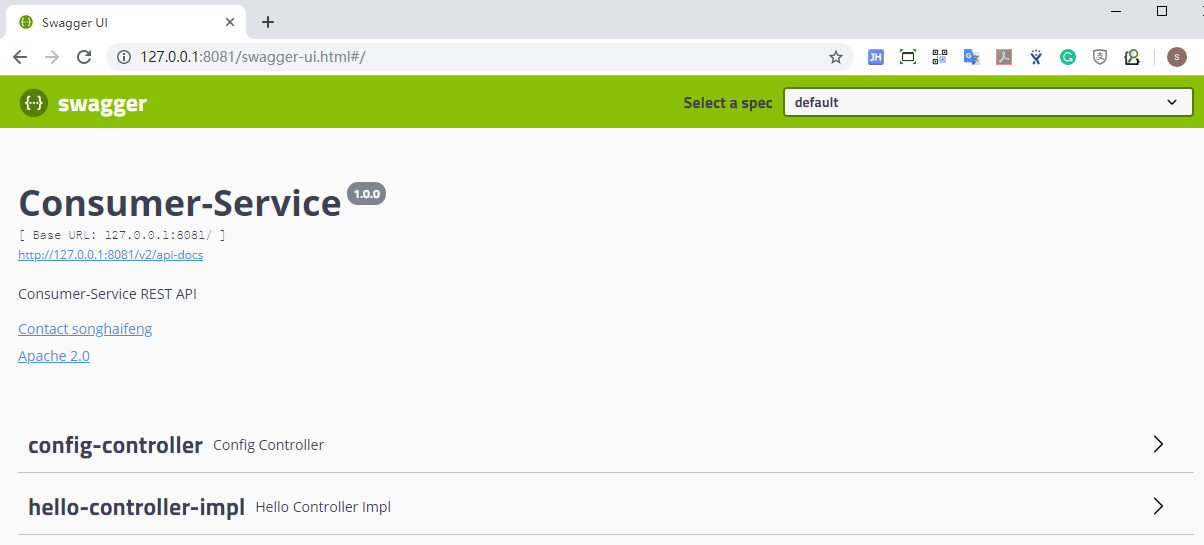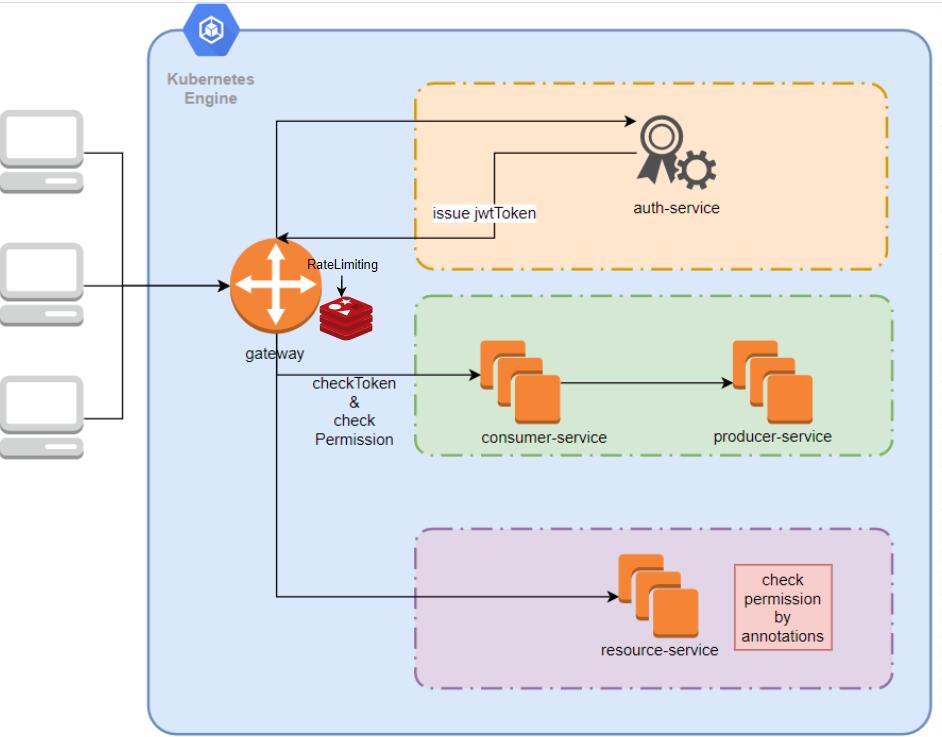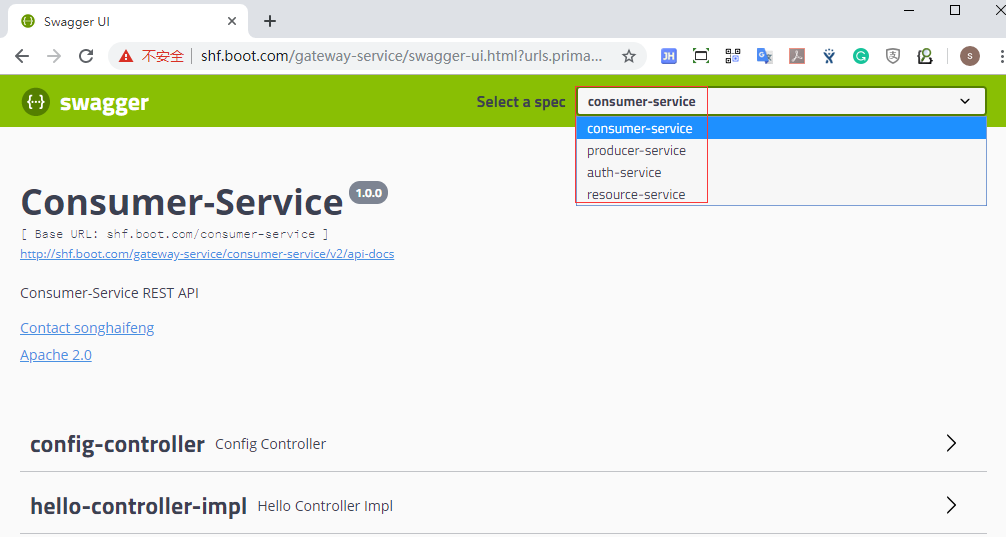A spring-cloud-kubernetes sample project builds on springboot-kubernetes-sample project. You can try k8s integrating with spring-cloud step by step, with all branches as follow.
- openfeign(step 1)
Only integrate openfeign without ribbon.
- ribbon-feign(step 2)
Integrate openfeign with spring-cloud-ribbon.
- kubernetes-ribbon-feign(step 3)
Integrate openfeign with spring-cloud-kubernetes-ribbon.
- configmap-secret(step 4)
Add kubernetes configmap & secret feature for configuration. See consumer-service for more detail.
- cloud-kubernetes-config(step 5)
Integrate spring-cloud-kubernetes-config for reloading configurations
- redis-rate-limiter(step 6)
Achieve distribute rate limiting by integrating spring-cloud-gateway with redis.
> token bucket algorithm
- master(last step)
Contains all features shown as follow.
- Others
- alibaba-sentinel
Integrate with spring-cloud-alibaba-sentinel, only test in dev. Do not test in k8s.
- alibaba-sentinel
- Integrate spring-cloud-openfeign for native declarative request
- Integrate spring-cloud-kubernetes-ribbon for discover and loadbalancer
- Integrate spring-cloud-gateway to route and filter backend services, Customized gatewayFilter for security
- Integrate Spring-security-oauth2, use JwtToken(enhancer base token) for authentication and authorization
- kubernetes configmap & secret for configurations
- Integrate spring-cloud-kubernetes-config for reloading configurations
- Distribute rate limiting, support
token bucketandscroll windowtwo algorithms - Custom header for api-version
- Customized FeignHeaderInterceptor for spreading http-headers into the downstream services
- Integrate swagger for API documents, and aggregate all services' swagger documents into gateway-service
- Deploy redis with standalone mode in K8S, and export access port
- okHttp3
$ mvn clean install -P k8sMore information can forward to REAMDE.md for detail description of building&deploying and so on.
$ kubectl apply -f ./kubernetes/0namespace.yaml
$ kubectl create secret generic private-secret -n springboot-kube --from-file=privatekey=./kubernetes/privatekey
$ kubectl apply -f ./kubernetes/redis/standalone/
$ kubectl apply -f ./kubernetes/For testing purposes, you can remove authentication filters{RequestAuthentication and RequestAuthorization} in the consumer service temporarily. Until test the security.
- request consumer-service directly
$ curl -H "Content-Type:application/json-v1" localhost:8081/hello/call/producer-serviceOUTPUT
Get response from producer-service : "hello anonymity, I am songhaifeng(hostname):8080(port).Receive token: none"
- request consumer-service by gateway-service
$ curl -H "Content-Type:application/json-v1" localhost:9999/consumer-service/hello/call/producer-service
OUTPUT
Get response from producer-service : "hello anonymity, I am songhaifeng(hostname):8082(port).Receive token: none"
- request consumer-service directly
$ curl -H "Content-Type:application/json-v1" shf.boot.com/consumer-service/hello/call/producer-service
- request consumer-service by gateway-service
$ curl -H "Content-Type:application/json-v1" shf.boot.com/gateway-service/consumer-service/hello/call/producer-service
$ echo -n "admin" | base64
YWRtaW4=
$ echo -n "123456" | base64
MTIzNDU2- test secret ref
$ curl 127.0.0.1:8081/secretOUTPUT
mongodb://admin:654321@mongodb/admin
- test config ref
$ curl 127.0.0.1:8081/single/config/variableOUTPUT
properties-variable0
- test batch config ref
$ curl 127.0.0.1:8081/batch/config/variables
OUTPUT
{"variable1":"properties-variable1","variable2":"properties-variable2"}
- test secret ref
$ curl http://shf.boot.com/gateway-service/consumer-service/secret
mongodb://admin:123456@mongodb/test
- test config ref
$ curl http://shf.boot.com/gateway-service/consumer-service/single/config/variable
configmap-variable0
- test batch config ref
$ curl http://shf.boot.com/gateway-service/consumer-service/batch/config/variables
{"variable1":"configmap-variable1","variable2":"configmap-variable2"}
- create secret
$ kubectl create secret generic private-secret -n springboot-kube --from-file=privatekey=./kubernetes/privatekey
secret "private-secret" created- check the mounted directory and data in the mounted file
$ kubectl exec $(kubectl get po -n springboot-kube | grep 'consumer' | awk 'NR==1{print $1}') -n springboot-kube -c consumer-service ls /etc/
$ kubectl exec $(kubectl get po -n springboot-kube | grep 'consumer' | awk 'NR==1{print $1}') -n springboot-kube -c consumer-service cat /etc/private-key.key
abc- request the reload_properties endpoint
$ curl http://shf.boot.com/consumer-service/reload/config/properties
{"property1":"configmap-reload-property1","property2":"configmap-reload-property2"}
- modify the config
$ kubectl apply -f ./kubernetes/configmap_reload/consumer-configmap-reload.yaml- check the config whether be reloaded?
$ curl http://shf.boot.com/consumer-service/reload/config/properties
{"property1":"configmap-reload1-property1","property2":"configmap-reload1-property2"}
Achieve distribute rate limiting by integrating spring-cloud-gateway with redis, using the token bucket algorithm.
Here is a guide document to introduce how to build a standalone redis-server in K8S.
Test the following cases through jmeter, can set the number of threads more than 20.
curl -H "userId:SOUL" shf.boot.com/gateway-service/consumer-service/hello/song
curl -H "userId:SONG" shf.boot.com/gateway-service/consumer-service/hello/song
When the rate limiting comes into effect, there will be two phenomena as follows:
- Get keys from redis
K8S:0>keys request_rate_limiter*
- "request_rate_limiter.{SONG}.timestamp"
- "request_rate_limiter.{SOUL}.timestamp"
- "request_rate_limiter.{SONG}.tokens"
- "request_rate_limiter.{SOUL}.tokens"
- Some requests could not be responded normally, they failed with response header which contains
429http-code, means too many requests.
HTTP/1.1 429 Too Many Requests
Server: nginx/1.15.10
Date: Sat, 18 May 2019 16:10:54 GMT
Content-Length: 0
Connection: keep-alive
X-RateLimit-Remaining: 0
X-RateLimit-Burst-Capacity: 10
X-RateLimit-Replenish-Rate: 5
Here's a lua script that implements a window-scrolling limiting strategy.
Setting the log level of the redis-server is warning, then execute the script with the command
redis-cli --eval scroll_window_request_rate_limiter.lua 'foo' , 5 10. See the detail log:
[8424] 22 Jun 17:44:39.312 # allowed: 1 ; allowed_numer: 4
[8424] 22 Jun 17:44:41.222 # allowed: 1 ; allowed_numer: 3
[8424] 22 Jun 17:44:42.159 # allowed: 1 ; allowed_numer: 2
[8424] 22 Jun 17:44:42.939 # allowed: 1 ; allowed_numer: 1
[8424] 22 Jun 17:44:43.734 # allowed: 1 ; allowed_numer: 0
[8424] 22 Jun 17:44:44.548 # allowed: 0 ; allowed_numer: 0
[8424] 22 Jun 17:44:45.305 # allowed: 0 ; allowed_numer: 0
[8424] 22 Jun 17:44:46.055 # allowed: 0 ; allowed_numer: 0
[8424] 22 Jun 17:44:49.569 # allowed: 1 ; allowed_numer: 4
[8424] 22 Jun 17:44:51.382 # allowed: 1 ; allowed_numer: 3
[8424] 22 Jun 17:44:52.556 # allowed: 1 ; allowed_numer: 2
[8424] 22 Jun 17:44:53.398 # allowed: 1 ; allowed_numer: 1
[8424] 22 Jun 17:44:56.493 # allowed: 1 ; allowed_numer: 0
[8424] 22 Jun 17:44:58.610 # allowed: 0 ; allowed_numer: 0
[8424] 22 Jun 17:45:00.417 # allowed: 1 ; allowed_numer: 4
The output is as expected, the window_size is 10 seconds and the capacity is 5.
We can just add RequestAuthentication and RequestAuthorization filters for consumer-service.
- get accessToken with username(foo1)
$ curl -XPOST "trusted-app:secret@localhost:3000/oauth/token" -d "grant_type=password&username=foo1&password=foo123"OUTPUT
{"access_token":"eyJhbGciOiJIUzI1NiIsInR5cCI6IkpXVCJ9.eyJhdWQiOlsic29uZyJdLCJ1c2VyX25hbWUiOiJmb28xIiwic2NvcGUiOlsid2ViQ2xpZW50IiwiYXBwQ2xpZW50Il0sIm9yZ2FuaXphdGlvbiI6ImZvby1vcmciLCJleHAiOjE1NjI2ODU4MzcsImF1
dGhvcml0aWVzIjpbIkFkbWluIiwiVXNlciJdLCJqdGkiOiI0ZTAxMzU5Yi05MDUxLTRhZDctODBhMC02NjM2YzAyYTk1NjEiLCJjbGllbnRfaWQiOiJ0cnVzdGVkLWFwcCJ9.oudLnwG5174X9mqpLl5TcZXvmwBFHPweg4AT7lDx_vw","token_type":"bearer","refre
sh_token":"eyJhbGciOiJIUzI1NiIsInR5cCI6IkpXVCJ9.eyJhdWQiOlsic29uZyJdLCJ1c2VyX25hbWUiOiJmb28xIiwic2NvcGUiOlsid2ViQ2xpZW50IiwiYXBwQ2xpZW50Il0sIm9yZ2FuaXphdGlvbiI6ImZvby1vcmciLCJhdGkiOiI0ZTAxMzU5Yi05MDUxLTRhZD
ctODBhMC02NjM2YzAyYTk1NjEiLCJleHAiOjE1NjI3MjcyMzcsImF1dGhvcml0aWVzIjpbIkFkbWluIiwiVXNlciJdLCJqdGkiOiIwNmZhMGJjOS05Y2QyLTQ1MDAtYTAzMC1lNmYwNjkwNzA2OTYiLCJjbGllbnRfaWQiOiJ0cnVzdGVkLWFwcCJ9.XiFVAg6IXXD_F31HjV6
TyZpUle66Fg6SpPU5I9Ebf3E","expires_in":1799,"scope":"webClient appClient","organization":"foo-org","jti":"4e01359b-9051-4ad7-80a0-6636c02a9561"}
Next will use the access_token for all request.
- call resource-service, has authorities.
$ curl -X GET "http://127.0.0.1:9999/resource-service/resource/authority_with_user" -H "Content-type: application/json;charset=UTF-8" -H "Authorization: Bearer {access_token}" OUTPUT
foo1
- call resource-service, has no authorities.
Authenticated by the resource service itself.
$ curl -i -X GET "http://127.0.0.1:9999/resource-service/resource/authority_with_clientId" -H "Authorization: Bearer {access_token}" -H "Content-type: application/json;charset=UTF-8"OUTPUT
HTTP/1.1 403 Forbidden
transfer-encoding: chunked
Cache-Control: no-store
Pragma: no-cache
X-Content-Type-Options: nosniff
X-XSS-Protection: 1; mode=block
X-Frame-Options: DENY
Content-Type: application/json;charset=UTF-8
Date: Tue, 09 Jul 2019 15:01:09 GMT
{"error":"access_denied","error_description":"Access is denied"}
- call producer-service without accessToken
$ curl -X GET "http://127.0.0.1:9999/producer-service/call/abc" OUTPUT
hello abc, I am songhaifeng(hostname):8080(port).Receive token: none
- call consumer-service with accessToken
$ curl -X GET "http://127.0.0.1:9999/consumer-service/hello/call/producer-service" -H "accept: text/html" -H "Content-type: application/json-v1" -H "Authorization: Bearer {access_token}" OUTPUT
Get response from producer-service : "hello foo1, I am songhaifeng(hostname):8082(port).Receive token: Bearer eyJhbGciOiJIUzI1NiIsInR5cCI6IkpXVCJ9.eyJhdWQiOlsic29uZyJdLCJ1c2VyX25hbWUiOiJmb28xIiwic2NvcGUiOls
id2ViQ2xpZW50IiwiYXBwQ2xpZW50Il0sIm9yZ2FuaXphdGlvbiI6ImZvby1vcmciLCJleHAiOjE1NjI2ODU4MzcsImF1dGhvcml0aWVzIjpbIkFkbWluIiwiVXNlciJdLCJqdGkiOiI0ZTAxMzU5Yi05MDUxLTRhZDctODBhMC02NjM2YzAyYTk1NjEiLCJjbGllbnRfaWQiO
iJ0cnVzdGVkLWFwcCJ9.oudLnwG5174X9mqpLl5TcZXvmwBFHPweg4AT7lDx_vw"
- get accessToken with username(foo1)
$ curl -XPOST "trusted-app:[email protected]/gateway-service/auth-service/oauth/token" -d "grant_type=password&username=foo1&password=foo123"OUTPUT
Next will use the access_token for all request.
- call resource-service, has authorities.
$ curl -X GET "shf.boot.com/gateway-service/resource-service/resource/authority_with_user" -H "Content-type: application/json;charset=UTF-8" -H "Authorization: Bearer {access_token}" OUTPUT
foo1
- call consumer-service with accessToken
$ curl -X GET "shf.boot.com/gateway-service/consumer-service/hello/call/producer-service" -H "accept: text/html" -H "Content-type: application/json-v1" -H "Authorization: Bearer {access_token}" OUTPUT
Get response from producer-service : "hello foo1, I am producer-service-dm-ddbb6477d-c54d7(hostname):8080(port).Receive token: Bearer eyJhbGciOiJIUzI1NiIsInR5cCI6IkpXVCJ9.eyJhdWQiOlsic29uZyJdLCJ1c2VyX25hbWU
iOiJmb28xIiwic2NvcGUiOlsid2ViQ2xpZW50IiwiYXBwQ2xpZW50Il0sIm9yZ2FuaXphdGlvbiI6ImZvby1vcmciLCJleHAiOjE1NjI3NzAwNDYsImF1dGhvcml0aWVzIjpbIkFkbWluIiwiVXNlciJdLCJqdGkiOiJhOGQ5ZWVmZi0xODYyLTQ3MzgtYTJmMC01ZmE4MmU3M
zEyNDAiLCJjbGllbnRfaWQiOiJ0cnVzdGVkLWFwcCJ9.Lg_pTJfbtYx3QgL5q9GBjmx-EO4dcvDr7qpcJ7olj38"
- consumer-service
http://127.0.0.1:8081/swagger-ui.html
 Once again, we can call all services' swagger-UI locally.
Once again, we can call all services' swagger-UI locally.
- gateway-service
Aggregate all swagger info for all services.
http://shf.boot.com/gateway-service/swagger-ui.html
If you want to use swagger directly without the gateway-service. PS add
springfox.documentation.swagger.v2.host=shf.boot.com/{ingress-router-path}in the application's env.

